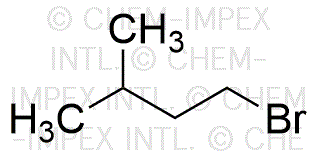1-Bromo-3-methylbutane is widely utilized in research focused on:
- Synthetic Organic Chemistry: This compound serves as a key intermediate in the synthesis of various organic molecules, allowing chemists to create complex structures efficiently.
- Pharmaceutical Development: It is used in the production of pharmaceutical compounds, aiding in the development of new medications by providing a versatile building block for drug synthesis.
- Polymer Chemistry: The compound acts as a reagent in polymerization processes, contributing to the creation of specialized polymers with tailored properties for applications in coatings and adhesives.
- Laboratory Research: Researchers utilize it in various experimental setups to study reaction mechanisms and to develop new chemical methodologies, enhancing the understanding of organic reactions.
- Environmental Chemistry: It is employed in studies related to environmental impact assessments, helping scientists analyze the behavior of organic compounds in different ecosystems.
General Information
Properties
Safety and Regulations
Applications
1-Bromo-3-methylbutane is widely utilized in research focused on:
- Synthetic Organic Chemistry: This compound serves as a key intermediate in the synthesis of various organic molecules, allowing chemists to create complex structures efficiently.
- Pharmaceutical Development: It is used in the production of pharmaceutical compounds, aiding in the development of new medications by providing a versatile building block for drug synthesis.
- Polymer Chemistry: The compound acts as a reagent in polymerization processes, contributing to the creation of specialized polymers with tailored properties for applications in coatings and adhesives.
- Laboratory Research: Researchers utilize it in various experimental setups to study reaction mechanisms and to develop new chemical methodologies, enhancing the understanding of organic reactions.
- Environmental Chemistry: It is employed in studies related to environmental impact assessments, helping scientists analyze the behavior of organic compounds in different ecosystems.
Documents
Safety Data Sheets (SDS)
The SDS provides comprehensive safety information on handling, storage, and disposal of the product.
Product Specification (PS)
The PS provides a comprehensive breakdown of the product’s properties, including chemical composition, physical state, purity, and storage requirements. It also details acceptable quality ranges and the product's intended applications.
Certificates of Analysis (COA)
Search for Certificates of Analysis (COA) by entering the products Lot Number. Lot and Batch Numbers can be found on a product’s label following the words ‘Lot’ or ‘Batch’.
*Catalog Number
*Lot Number
Certificates Of Origin (COO)
This COO confirms the country where the product was manufactured, and also details the materials and components used in it and whether it is derived from natural, synthetic, or other specific sources. This certificate may be required for customs, trade, and regulatory compliance.
*Catalog Number
*Lot Number
Safety Data Sheets (SDS)
The SDS provides comprehensive safety information on handling, storage, and disposal of the product.
DownloadProduct Specification (PS)
The PS provides a comprehensive breakdown of the product’s properties, including chemical composition, physical state, purity, and storage requirements. It also details acceptable quality ranges and the product's intended applications.
DownloadCertificates of Analysis (COA)
Search for Certificates of Analysis (COA) by entering the products Lot Number. Lot and Batch Numbers can be found on a product’s label following the words ‘Lot’ or ‘Batch’.
*Catalog Number
*Lot Number
Certificates Of Origin (COO)
This COO confirms the country where the product was manufactured, and also details the materials and components used in it and whether it is derived from natural, synthetic, or other specific sources. This certificate may be required for customs, trade, and regulatory compliance.


